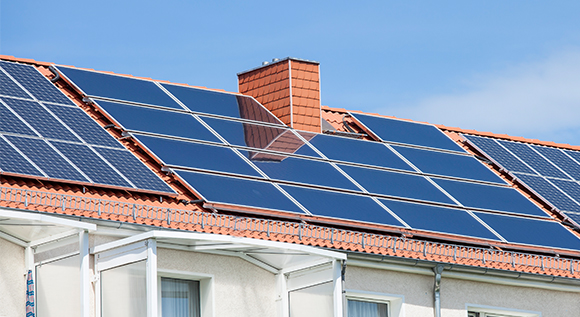Battery storage can take the strain off the electricity grid
A combination of photovoltaics and battery storage improves the extent to which homes can supply their own electricity. Many people believe that this combination puts more strain on the grid, but the results of a research project funded by the Federal Ministry for Economic Affairs and Energy show otherwise.
 © BMWi/ Maria Parussel
© BMWi/ Maria Parussel
You are using your washing machine. The 60 degree wash cycle stops and so does energy consumption. From one moment to the next, the solar panels on the roof feed all of the electricity they generate into the grid again. These quick shifts between electricity consumption and generation are a central problem for managing the grid.
Battery storage systems can help cushion these fluctuations. This has been shown by a joint research project conducted by the University of Applied Sciences (RWTH) in Aachen and the Institute for Ecological Economy Research (IÖW) in Berlin. Just take the example of the 60 degree wash cycle again: the moment you turn on the washing machine and electricity consumption goes up, electricity is taken from the battery storage system to cover the electricity demand in your home. This reduces the amount of electricity that has to be taken from the public grid. It also works the other way round. The moment you turn off the washing machine and your solar system suddenly produces a surplus of electricity, this electricity is stored. Consequently, the grid does not have to cope with so much electricity being fed in.
Fewer feed-in peaks
Smart battery storage technology that uses so-called persistence forecasts can further reduce the strain on the grid. Based on the amount of electricity consumed the previous week and the solar PV's generation profile, the system determines how much electricity should be stored. This can considerably reduce feed-in peaks. These forecasting strategies can also help to extend the life of lithium ion batteries as they prevent placing heavy loads on the battery or overloading it, and therefore slow the ageing process of the systems.
If the electricity that is fed into the grid is limited to 60 per cent of the solar system’s maximum output – a condition for receiving funding under the KfW "Renewable Energies Programme - Storage" – feed-in peaks are reduced even more efficiently.
The broad-based research project is sponsored by the Institute for Power Electronics and Electrical Drives (ISEA) and the Institute for High Voltage Technology (IFHT) at the RWTH Aachen (expertise in storage technologies and power system simulation) in cooperation with the Institute for Ecological Economy Research (IÖW) in Berlin. The Federal Ministry for Economic Affairs and Energy has funded the project under the Federal Government’s Energy Research Programme.

